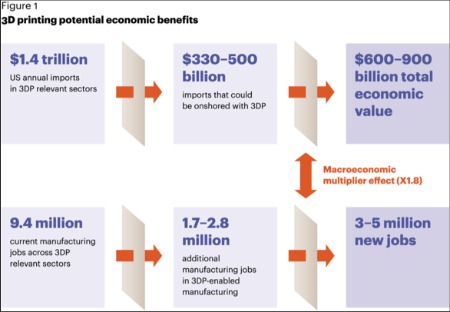3-D printing’s economic benefits are too big to ignore

Over the next 10 years, 3-D printing can realistically add more than 3 million jobs to the United States economy and deliver more than $600 billion in total economic value.
These are the key findings of a comprehensive analysis recently completed by A.T. Kearney, in cooperation with Penn State University’s Center for Innovative Materials Processing through Direct Digital Deposition (CIMP-3D).
3-D printing, also known as additive manufacturing, is already widely used for rapid prototyping and production of low-volume, high-value parts where customization and time to market are key value drivers. For example, nearly all ear pieces for hearing aids are now 3-D printed. Dentistry is also rapidly adopting 3-D printing.
{mosads}Yet, these current applications mark no more than the beginning. Faster printing speeds, imminent progress toward simultaneously printing metal and plastic and expanding “build envelopes” will soon make 3-D printing much more broadly competitive, revolutionizing a range of traditional production processes.
Our analysis sought to gauge the potential economic benefits of 3-D printing. The resulting study, “3D Printing and The Future of The U.S. Economy,” pursued two closely connected lines of inquiry.
We surveyed more than 100 executives with affirmed knowledge of 3-D printing and found that nearly all (96 percent) believe that 3-D printing has potential to promote onshoring of manufacturing. More than two-thirds see “some” or “high” onshoring potential.
These findings are consistently confirmed by executives our teams have interviewed as participants in “Shaping The Future of Production,” a World Economic Forum global initiative. Our executive research also suggests that 3-D printing will have the greatest near-term impact in five sectors: industrials, automotive, consumer products, health care/medical and aerospace.
To calculate the total economic value, the U.S. might realistically gain using 3-D printing across those five sectors, we next referenced various macroeconomic data compiled by a range of authoritative sources, including the U.S. Bureau of Economic Analysis, the National Association of Manufacturers, the U.S. Bureau of Labor Statistics and the Organization for Economic Cooperation and Development.

A significant component of the resulting projection is the macroeconomic multiplier effect (MME), by which a gain in one form of economic value causes economic stimulus in related areas (e.g., professional services, finance and insurance, retail).
Our review of relevant research by the National Association of Manufacturers suggests that the adjacent benefits of 3-D printing will be substantial. Accordingly, we applied an MME factor of 1.8X.
As important, our analysis strongly suggests that the jobs 3-D printing could add to the U.S. economy would include many roles requiring considerable skill, thus warranting relatively high levels of compensation. The improving economics of 3-D printing could soon make such a scenario both attainable and sustainable.
In sum, our findings suggest that millions of jobs and hundreds of billions in economic benefits could soon be gained through the advance of 3-D printing. Realizing these substantial (and urgently needed) economic benefits could be accelerated by legislation and policies supporting:
Educational reform: Expand 3-D printing-related curricula at government-funded colleges, universities and vocational schools.
Research and development: Increase public investments in 3-D printing R&D programs with immediate government applications, which would help speed application in the private sector.
Incentives: Encourage private investment in 3-D printing through tax breaks and grants tied specifically to reshoring offshored manufacturing jobs.
Intellectual Property: Establish clear “rules of the road” for intellectual property and data security to help mitigate risks of investing in cutting edge 3-D printing technology.

3-D printing’s economic potential is too big to ignore, while the cost of hastening that potential into economic reality seems comparatively small.
Sean Monahan is a partner with the global management consulting firm A.T. Kearney, leading the Operations & Performance Transformation Practice in the Americas region. Tim Simpson is Paul Morrow professor of engineering design and manufacturing at Pennsylvania State University.
Copyright 2023 Nexstar Media Inc. All rights reserved. This material may not be published, broadcast, rewritten, or redistributed.


